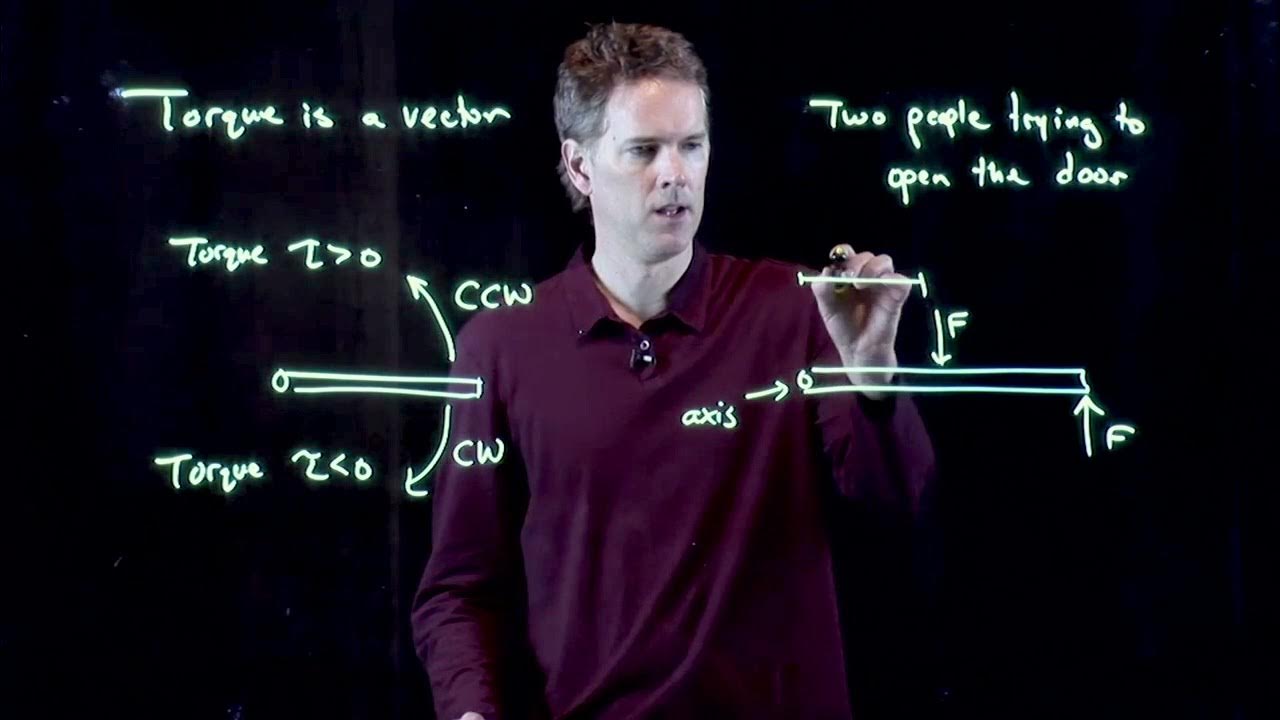The Right Hand Rule for Torque
TLDRIn this engaging physics lesson, students learn to determine the direction of torque using the right-hand rule. The instructor, Mr. P, clarifies that torque is the force's ability to cause angular acceleration and demonstrates the right-hand rule's steps. Students are guided to visualize the force's direction and apply it to various examples, including scenarios where the force's direction changes or the axis of rotation moves. The discussion highlights the right-hand rule's relevance to angular displacement and velocity, emphasizing that torque's direction is related to the force's application, not the force itself. The lesson also clarifies that the right-hand rule is not applicable to determining the direction of forces and that it does not provide a direction when torque is zero. The class concludes with a reminder that the right-hand rule is specifically for torque direction, fostering a deeper understanding of this fundamental concept.
Takeaways
- 🔧 The direction of torque is an important concept when studying the ability of a force to cause an angular acceleration of an object.
- 👉 The right hand rule is a handy tool used to identify the direction of torque.
- 🤚 Step one of the right hand rule involves placing the fingers of your right hand at the axis of rotation.
- 👉 Step two involves pointing your fingers along a line from the axis of rotation to where the force acts on the object.
- 🤞 Curling your fingers in the direction of the force and then extending your thumb indicates the direction of torque.
- 📌 If the thumb points out of the board, it's considered positive torque; if it points into the board, it's negative.
- 🔄 The right hand rule is related to the direction of angular displacement and velocity, as the object will angular accelerate in the same direction as the torque.
- 🔄 The direction of torque is dependent on the position of the force relative to the axis of rotation, not just the direction of the force itself.
- ⚖️ When the force is applied directly in line with the axis of rotation, the torque is zero and thus has no direction.
- 🚫 The right hand rule should not be used to determine the direction of forces, only the direction of torque.
- 📚 Understanding the right hand rule helps in determining the direction of torque, which is essential for analyzing rotational motion in physics.
Q & A
What is torque?
-Torque is the ability of a force to cause an angular acceleration of an object. It is a measure of the rotational force that can be applied to an object to produce a twisting motion around an axis.
What is the right hand rule?
-The right hand rule is a mnemonic tool used to determine the direction of torque. It involves positioning your right hand with the fingers and thumb at right angles to each other, with the fingers representing the direction of the force and the thumb indicating the direction of the torque.
What is the first step of the right hand rule?
-The first step of the right hand rule is to position the fingers of your right hand at the axis of rotation of the object.
How do you determine the direction of torque using the right hand rule?
-You point your fingers along a line from the axis of rotation to where the force acts on the object, curl your fingers in the direction of the force, and then your right thumb indicates the direction of the torque.
What is considered as the positive direction of torque in the given examples?
-In the given examples, torque that is 'out of the board' is considered to be positive.
What is considered as the negative direction of torque?
-Torque that is 'into the board' is considered to be negative, as it is opposite to the positive direction.
How is torque related to angular displacement and angular velocity?
-The direction of the torque is related to the direction of the angular displacement and angular velocity of the object. A torque will cause the object to angularly accelerate in the direction of the torque.
What happens if the force is applied at an angle to the object?
-If the force is applied at an angle, the right hand rule still applies. You position your fingers from the axis of rotation to the point of force application, curl your fingers in the direction of the force, and your thumb will indicate the direction of the torque.
What is the significance of the axis of rotation in determining torque?
-The axis of rotation is significant as it is the point from which you start when applying the right hand rule. The direction of the torque can change depending on the position of the axis relative to the force applied.
What is the torque when the force is applied directly in line with the axis of rotation?
-When the force is applied directly in line with the axis of rotation, the torque is zero because the sine of the angle between the position vector (r) and the force vector is zero (sin(0) = 0).
Why is the right hand rule not used for determining the direction of forces?
-The right hand rule is specifically for determining the direction of torque, not force. It is based on the cross product which is used in torque calculations, and does not apply to force directions in the same way.
What is the mathematical formula for torque?
-The mathematical formula for torque (τ) is τ = r × F, where r is the position vector from the axis of rotation to where the force is applied, and F is the force causing the torque. The torque is maximized when the force is applied perpendicular to the position vector.
Outlines
📚 Understanding Torque Direction with the Right Hand Rule
This paragraph introduces the concept of torque direction and the tool used to determine it, the right hand rule. The discussion starts with a question about the tool, leading to the correct answer, the right hand rule. The steps of the right hand rule are outlined through a dialogue between Mr. P and the class, emphasizing the importance of starting with the fingers at the axis of rotation, pointing towards the force application, and then using the thumb to indicate the direction of torque. Examples are given to illustrate how changing the force's direction affects the torque's direction, with positive torque being 'out of the board' and negative torque being 'into the board.' The relationship between torque and angular displacement is also explored, highlighting that torque causes angular acceleration in the same direction as the torque itself.
🚫 The Right Hand Rule is Not for Force Direction
The second paragraph emphasizes the specific use of the right hand rule for determining the direction of torque, not force. It clarifies that while some students might be tempted to use the rule for forces, it is only applicable to torque. The dialogue corrects a misconception and reinforces the rule's purpose. The paragraph also explains scenarios where the right hand rule does not apply, such as when the torque is zero because the angle between the force and the position vector is zero, resulting in no direction for the torque. The summary concludes with a reminder that the right hand rule is solely for torque direction, and a note of gratitude for the engagement in the learning process.
Mindmap
Keywords
💡Torque
💡Right Hand Rule
💡Angular Acceleration
💡Axis of Rotation
💡Positive Torque
💡Negative Torque
💡Angular Displacement
💡Force
💡Direction of Torque
💡Zero Torque
💡Position Vector
Highlights
Introduction to the concept of torque and its direction.
The right hand rule is introduced as the tool to identify the direction of torque.
Step one of the right hand rule is to position the fingers of the right hand at the axis of rotation.
Step two involves pointing fingers towards where the force acts on the object and curling them in the direction of the force.
The thumb of the right hand indicates the direction of the torque.
Torque direction is positive when it is out of the board and negative when it is into the board.
Billy demonstrates how to apply the right hand rule to determine torque direction in a given example.
Bobby asks if the right hand rule for torque is related to the one for angular displacement and velocity.
Bo explains that torque causes angular acceleration in the same direction as the torque itself.
Mr. P confirms the relationship between torque direction and angular displacement.
Bobby determines the direction of torque with the axis of rotation on the left side of the object.
Bo explains that when the force is applied on the opposite side of the axis, the torque direction can remain the same.
Billy clarifies that the right hand rule gives the direction of torque, not the force.
The angle in the torque equation is zero when the force is applied directly on the axis of rotation, resulting in zero torque.
Billy explains the torque equation involving the position vector, force, and sine of the angle between them.
Mr. P emphasizes that the right hand rule is for torque direction only and should not be used for forces.
The class concludes with a reminder that the right hand rule is specific to torque and not a general tool for all directions.
Transcripts
Browse More Related Video

Angular Momentum and Cross Product | Physics with Professor Matt Anderson | M12-15

Torque is a Vector | Physics with Professor Matt Anderson | M12-11

torque explained

Cross product and torque | Moments, torque, and angular momentum | Physics | Khan Academy

Torque as a Cross Product | Physics with Professor Matt Anderson | M12-08

What is a Moment?
5.0 / 5 (0 votes)
Thanks for rating: